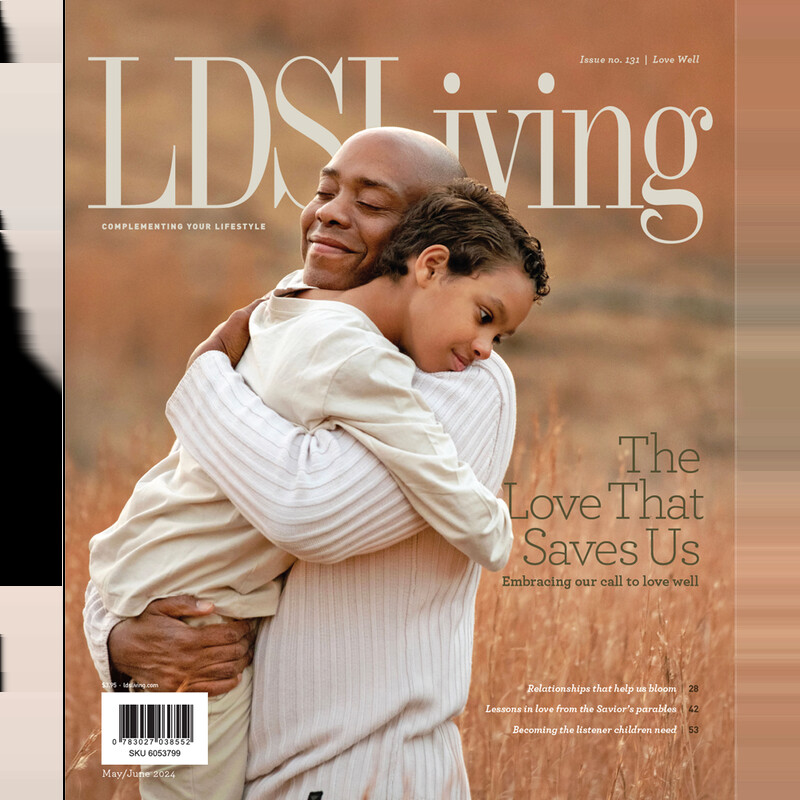Editor's note: This excerpt is part three of a three-part series featured in this month's LDS Living magazine.
Throughout His mortal ministry, Jesus Christ instructed His followers how to love the way He loves, not only by His example but in many of His parables. Over the next few weeks, we'll look at three parables to explore the simple yet radical lessons He taught about how we can learn to “love well.” Read part one and part two.
To love others, we need to understand two key principles—repentance and forgiveness.
A beautiful story about this truth surrounds a parable found in Luke 7:41–43. The story begins in verse 37 when Jesus was dining with a Pharisee named Simon. During the dinner, a woman entered Simon’s home, fell at the Savior’s feet, and began washing His feet with her tears.
Her love and devotion are palpable and profound. Upon seeing this emotional display, Simon muttered in his mind, “This man [meaning Jesus], if he were a prophet, would have known who and what manner of woman this is that toucheth him: for she is a sinner” (verse 39).
Discerning Simon’s thoughts, Jesus told him this parable. Two men owed the same creditor money; one owed a significant amount, the other a meager amount in comparison. When neither was able to pay his debt, the creditor forgave both debts in full.
Then Jesus asked Simon, “Tell me therefore, which of them will love him [the creditor] most?” Simon astutely answered, “I suppose that he, to whom he forgave most” (verses 42 and 43). Like the parable of the good Samaritan, Jesus told this parable in a way that the answer was not difficult to decipher.
Then, turning directly to face the woman, Jesus asked, “Seest thou this woman?”
I get teary almost every time I read this question. I imagine that Simon had never really seen her—as a person with worth, with feelings, with God-given gifts. In truth, not many people ever saw her.
Jesus continued, explaining that Simon performed the bare minimum for His guest, but this woman showed Him kindness, care, and hospitality beyond anything one would ever expect. Clearly, Jesus illustrated that this woman loved much; she exemplified heartfelt and genuine love.
Looking deeper, we must conclude that the woman had not only encountered Jesus previously but had been changed for the better as a result. This process must have included repentance and forgiveness, as evidenced by her gratitude and appreciation for her Redeemer.
Of note, the verb tense in Greek used to introduce the woman in verse 37, “a woman in the city, which was a sinner,” suggests an action from the past that is now completed, allowing us to read it as: “a woman in the city, which had been a sinner but was one no longer.”
This interpretation fits with the declarations Jesus made at the end of this story. Speaking of the woman, He said to Simon, “Her sins, which are many, are forgiven; for she loved much: but to whom little is forgiven, the same loveth little.” Then, speaking directly to the woman, Jesus declared, “Thy sins are forgiven. … Thy faith hath saved thee; go in peace” (Luke 7:47–50).
Wouldn’t you love to hear this woman bear her testimony in your sacrament meeting? Wouldn’t you love to minister to her or with her? I could learn a lot about how to love others from her.
Let’s explore a few lessons from this parable and story. At first glance, we could mistakenly conclude that Jesus is teaching that the more we sin, and the worse our sins are, the greater our capacity to love. Common sense and everything we know from prophets and from the Savior Himself screams that such an interpretation cannot be correct.
When we consider the woman juxtaposed with Simon, a better interpretation emerges.
Simon seems to think that since this woman had been a sinner, she must always be one and that he himself had no need of forgiveness. Simon’s hubris blinded him from recognizing that “all have sinned, and come short of the glory of God” (Romans 3:23) and that “[if] we say that we have no sin, we deceive ourselves, and the truth is not in us” (1 John 1:8).
The lesson here is that when we acknowledge our sins and turn to Jesus Christ in sincere repentance, the blessings that can come only from the Lord, including His forgiveness, produce an unprecedented capacity to love: to love the Lord for His unparalleled gift, and then to love others as He has loved us.
To say it in other words, we cannot truly love others until we give away our sins and turn to our Savior in humility and love, asking for His forgiveness.
In a world where increasing numbers of people feel isolated and unseen, the parables of Jesus teach us to forget ourselves and see many who will warm to our compassion, assistance, and non-judgmental friendship. Together, we can learn to love as He loves us.
Read more in the LDS Living May/June 2024 magazine
Our hope is that something in this issue inspires you to make space in your life for love: space to recognize it, offer it, and—perhaps most importantly—receive it. Plus, find excerpts from our best recent podcast episodes, comments from our readers, a recipe, fun facts, and more! Available at Deseret Book and deseretbook.com.
Our bi-monthly LDS Living print magazines are included with Deseret Book Platinum Rewards memberships. We also have a stand-alone subscription available. Manage your subscription here.
▶You may also like: Love lessons from the Savior’s parables, part 2: Our job is to love, not judge



